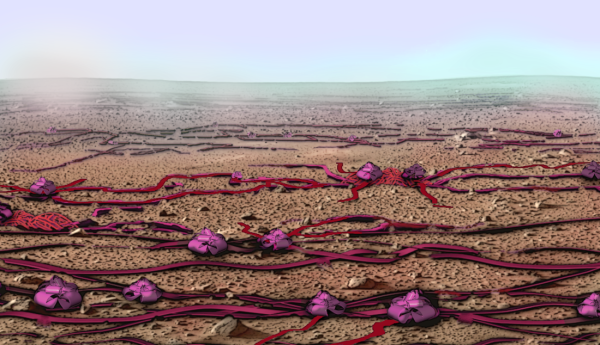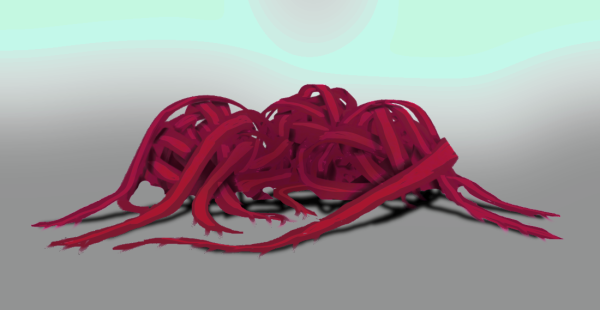BY LETTER
Thiogen Plant Life
 Image from Steve Bowers | |
| a view of a ribbonplant chaparral-type ecosystem on the Thiogen-seeded world of Haraktet | |
Thiogen Plant Life
In many of the biospheres of the 158 known Thiogen-colonized worlds, Terragen explorers have categorized two main kingdoms of photosynthesising multicellular life: the ribbon plants and the bubble plants, each of which appear to have evolved multicellularity separately. Both kinds have a dark red photosynthetic pigment characteristic of Thiogen biospheres.Ribbon Plants (vittathiophyta)
Basal ribbon plants are long but thin, with only a few cell layers. Nutrients can diffuse through the ribbon without the need for vascular tissue. Growth only occurs at the two ends of the ribbon. If cut, the two halves can operate as independent organisms, with the cut becoming a new growth surface. Reproduction occurs by shedding the tips of the ribbon.Many diverse clades have evolved from the basal form. In particular, the ribbons can exude calcium sulphate and silicone resin support structures, and even shape these exudates into vascular structures linking different parts of the ribbon. Two of the most prominent clades are conetrees and rufflegrass.
In conetrees, the ribbon grows in a spiral pattern to form a hollow cone. As the tip grows, the base expands and the cone becomes taller. In the hollow interior of the cone, the ribbons form stalactites of exudate to help support it. At the base of the cone, the other end of the ribbon grows into a flat spiral along the base, building a vascular root structure from exudates.
In rufflegrass, ribbons grow into a characteristic ruffle shape, alternately touching the ground and lifting into the air. Rufflegrass divides regularly, forming clonal colonies linked by exudate vascular systems. Tangled, chaotic meadows of rufflegrass are important ecosystems in many thiogen worlds.
 Image from Steve Bowers | |
| a common ribbon plant from the Thiogen world of Rosas IV | |
Bubble Plants (bullathiophyta)
A kingdom of photosynthetic multicellular organisms common on thiogen worlds. Like all thiogen plants, the photosynthetic pigment is dark red.Bubble plant cells produce an extracellular matrix of silicone surfactants and inflate bubbles out of it. Stoma cells link the interior and exterior, and photosynthetic cells can slide efficiently across the surface to track the sun.
Different clades grow as single large bubbles, paired of triplet bubbles, or mounds of foam. Some variants store water and nutrients in the bubbles. Some foam types inflate their surface bubbles with a noxious (by vitriolic standards) fluid, which can pop to deter browsers.
The most notable variant are the eyeplants of Pyritia. In these organisms, the spherical outer bubbles of the foam have evolved into image forming eyes, with a pupil opening in the photosynthetic cells. Because motion on the cells is efficient, the eyes can move quickly in response to stimuli, watching anything moving in the vicinity. If a potential threat approaches too closely, the eyes will distend and pop. Nearbaseline humans sometimes find this behaviour disconcerting.
Related Articles
Appears in Topics
Development Notes
Text by Liam Jones
Initially published on 17 December 2023.
Initially published on 17 December 2023.






